“Don’t get me wrong the six Chardonnays on show were all excellent wines, with the audience getting more excited as we moved on … but then we tried Virginia Willcock’s 2018 Vasse Felix Heytesbury Margaret River Chardonnay.”
The Gingin clone is the most commonly planted clone of Chardonnay in Margaret River, it is known both for its tendency to produce loose grape bunches with berries of different sizes and for making complex and elegant wines, but its history has been unclear. There have been various competing theories about its relation to two other widely planted Chardonnay clones Old Foundation Block and Mendoza, with some saying Gingin was perhaps a clonal derivation from either.
The exact origin of the clone have been the subject of debate for over 60 years but a recent study in the Australian Journal of Grape and Wine Research delved into the background of the clone and discovered that all three Chardonnay clones have a shared heritage and come from a source block at UC Davis in California, from the Chardonnay-1 clone, and that all are perfectly distinct from one another. The Gingin clone was first introduced into Western Australia in 1957 most probably by Harold Olmo, the acclaimed professor of viticulture at UC Davis, who had compiled a full survey of the Western Australian wine industry a couple of years previously.

Gingin clones
Move on a decade and Dr Tom Cullity plants the first commercial vineyard in Margaret River at Vasse Felix, although Chardonnay did not follow until 1975 where it was planted at Ashbrook Estate, Moss Wood and Leeuwin Estate. So although the Gingin clone was introduced in 1957 it took nearly 20 years before it started producing any Chardonnay.
Margaret River World Class Chardonnay
The webinar in which Gingin and soil types of Margaret River were discussed in detail was entitled Margaret River World Class Chardonnay, and whilst the Australians love to brag about their success, there was only one ‘world class’ Chardonnay in this line-up. Don’t get me wrong the six Chardonnays on show were all excellent wines, with the audience getting more excited as we moved on and the 2018 Flametree SRS Wallcliffe Chardonnay getting high praise with its forward, vivacious purity, full of energy, but then we tried Virginia Willcock’s 2018 Vasse Felix Heytesbury Margaret River Chardonnay, which showcases Virginia’s brilliance… well, what a wine!

Virginia Willcock, chief winemaker, Vasse Felix
It may be odd to talk about just one wine from a range tasting but this Heytesbury is so good that it deserves its unique place. Willcock stated that she has “unique natural wild yeasts only found in Western Australia, the vineyards are slow ripening, the grapes are hand-picked, the fruit cold pressed, whole bunch,” all pretty normal pointers in making great Chardonnay, but it is her stewardship as chief winemaker at Vasse Felix since 2006 that has enabled her to nurture unique small vineyard sections to be able to produce this marvel.
In these webinars where ‘technical correctness’ of a wine and winemaking are paramount it was unusual (and refreshing) to hear Willcock say “it’s all about getting dirty and screwed.” What she meant by that was that when she first left university she followed the line, rule by rule, but as time went by and with more experience she realised that to make great wine she had to get in the vineyard and really get her hands dirty and “play around with solids and wild yeasts…. forget what you learnt at university and, of course, seal it with a screw cap.”
I remember my first visit to Margaret River back in the early 2000s – when most of Australia was producing big oaky Chardonnays this glorious region was already refining its Chardonnay and laying the foundations for some of the greatest wines that this grape can produce, from Cullen to Moss Wood to Leeuwin and, of course, Vasse Felix.

But what is so good about this Vasse Felix Heytesbury Chardonnay 2018?
Since its inaugural release in 2000, Heytesbury has forged a world-wide cult following that has seen it become a New World benchmark Chardonnay. A selection of the most unique and striking vineyard plots, it has also Willcock’s innovative winemaking to ‘thank’.
As a wine? well for a start it has that restrained complexity, perfect balance between depth and freshness a wine that has that unique gentle Margaret River acidity, beeswax, touch of salinity, sweet delicate pineapple with cashews, lemon sponge biscuits, just so pure and sensational on the palate. A few guests in the audience reflected its similarity to some French names…. not necessary – this is Margaret River Chardonnay at its very best, world class, we do not need to compare it, this wine stands up by itself.
Here is a round up of the other wines tasted:
Thompson Estate Chardonnay 2018, delicate, expressive, citrus with fine stone fruit. Flametree SRS Wallcliffe Chardonnay 2018: great energy, fireworks, flinty, limey and forward. McHenry Hohnen Hazel Vineyard Chardonnay 2017: gentle and relaxed, touch of salinity, minerals, some toasty and vanilla background, delicate acidity. Voyager Estate MJW Chardonnay 2017: quite youthful and tight, tropical spices and guava, tangerine, sweet melon, creamy, almonds with a clean fresh finish. Xanadu Reserve Chardonnay 2017: fresh new oak flavours, lime and lemon curd, the 39-year-old vines give it a lovely depth and character, mouth-watering fresh on the palate.
Ah with all this excitement we have forgotten all about the Gingin clone, but rest assured this tasting proved that the clone certainly does work in Western Australia, with its “Mediterranean climate with a maritime influence,” the clone produces a more fruit-forward wine due to the bunches ripening slower and retaining more flavour. It is also renowned for its wonderful acidity and elegance with, of course, depth of flavour.









































